Thermal Imaging, Thermal Cameras, The Movie Predator and Now in Your Own Pocket
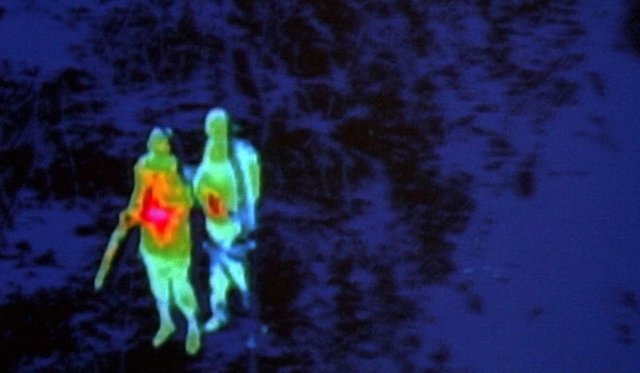
(source)
For most people the first peek at thermal imaging were the scenes from the 1987 movie Predator with Arnold Schwarzenegger where the alien used thermal vision to track his prey. Interestingly enough this was probably the first movie to use an actual thermal imager back in the day when they were still really expensive and far from what they are capable nowadays. This is precisely for a lot of people when talking about thermal cameras the images from the movie pop up in their heads, especially the first one, even though thermal imagers were used in most of the sequels after that, though some apparently resorted to "faking" it with CG as well.
There is a common misconception about thermal imaging cameras and that is regarding what kind of information they actually record with a lot of people thinking that the colorful image they see is actually what a thermal camera records. Well, maybe even that Predator movie is partially responsible for that misconception, but thermal imaging cameras actually do not record any color information. The reason for that is pretty simple - they do not operate like regular cameras that work in the part of the electromagnetic spectrum that is visible (400–700 nm range) and we can distinguish colors in, they operate in the a much higher part of the electromagnetic spectrum (8000–15000 nm).
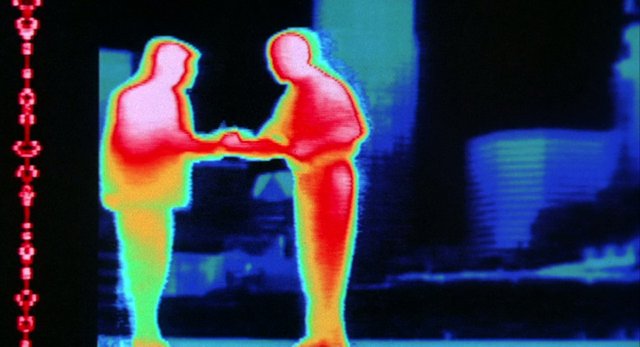
(source)
Thermal cameras record infrared radiation emitted from objects and save it as a temperature information and not color information, this means that each pixel does not have RGB values associated with it that represent certain color, but instead has a temperature value. You can think of this as being more like a grayscale image where the lighter a pixel is, the hotter it normally is, though that is just an example representation. The example with grayscale is also what different color representations of thermal images also do, like in the movie Predator, to make things seem easier to understand a LUT or a lookup table of colors is being used where different temperatures are represented by different colors. I'll get in more details in a separate post, just want to tell you that the Predator movie for example uses the so called Rainbow lookup table to represent the difference in temperature of the objects in a frame.
Another common misconception about the thermal imagers or cameras is that they are "infrared cameras", but that is not entirely true and is a confusing term to describe them, even though they actually do work in a part of the infrared spectrum. The term infrared camera is mostly used to describe regular digital cameras or even security cameras with night vision that are designed to be more sensitive in the near infrared region of the electromagnetic spectrum (over 700nm to about 1000nm). Thermal imaging cameras operate in a much higher part of the infrared range or the so called Long-wavelength infrared region of about 8000 to 15000 nm. Regular digital camera sensors are not sensitive enough to even reach close to this region, that is why thermal imaging cameras do rely on special type of sensors and not on regular CCD or CMOS sensors used in consumer cameras. This is also the reason why thermal cameras are much more expensive than a regular digital cameras, though in the last few years they have started becoming more affordable and accessible to regular users and not only to professionals that use them for work.
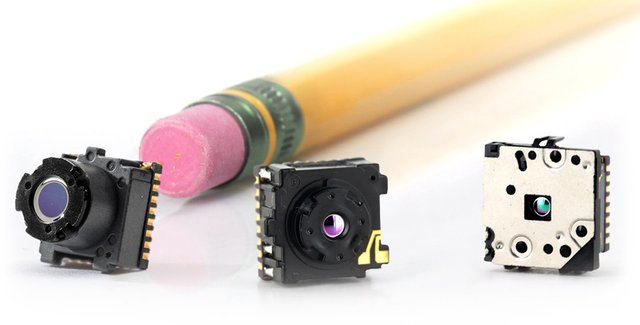
Affordable Consumer Thermal Imaging Cameras
Here is a list of some more affordable thermal imaging cameras that you can purchase and play with without having to pay too much to get your hands on the technology. Of course there are some limitations that you can expect such as the lower resolution of the thermal imager and the low framerate you will get if the camera is capable of recording videos. The recent spike in interest in thermal cameras was pretty much caused by the availability of inexpensive sensors such as FLIR Lepton for example. These small and inexpensive sensors quickly found their way into accessories for mobile phones that add thermal vision capabilities to your device. The fact that the phone takes the role of processing and display device allows to greatly reduce the extra cost of these thermal imaging devices as compared to traditional all-in-one solutions.
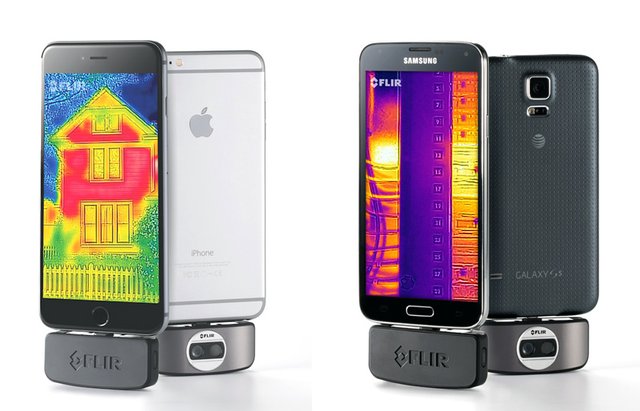
FLIR One Thermal Imager for iOS and Android Devices
I have been using standalone thermal imaging cameras in my work for a few years already and when the first FLIR One came out I was really curious how well it would work, so I did not wait much to get one. Back in the time it was pretty much the first thermal imaging smartphone accessory that relied on the first generation of FLIR Lepton sensor to come out on the market (80x60 pixels thermal resolution). The product was initially designed only for Apple's iPhone 5/5S as it came in a special accessory case that attached only to these iOS devices.
There were a couple of interesting features available that were introduced with it that were new to the not so high-end thermal imaging cameras that were available back then. These included the ability to actually record thermal videos with it (low resolution and framerate), but still something that is not yet available to the more affordable standalone thermal cameras. This was possible thanks to using the pretty fast processing power of the iPhone to work with the data captured with the sensor. The other one is the ability to record two images and superimpose them in order to create a higher-resolution looking end result, the lower resolution thermal image gets upscaled and on top of it a higher resolution visual image is overlaid providing contour of actual objects. The end result of the so called FLIR MSX blending gives the impression of actually using a higher resolution thermal imager than what you actually have in terms of thermal imager resolution.
The second generation FLIR One Thermal Imager that was introduced later on was made to be compatible with a wider array of devices and not be fixed only for a specific brand and model(s) of smartphones like the first gen. It became available in a more compact form and available in separate versions for both iOS and Android devices. It also offered some slight improvement in the specifications such as higher temperature sensitivity and apparently a better thermal resolution, not to mention the much more convenient and smaller size of the whole thing that you can easily carry in your pocket for example.
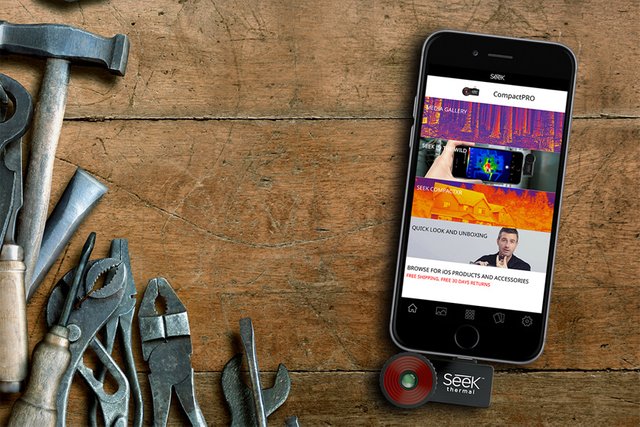
Seek Thermal Compact Imager for iOS and Android Devices
The other main player in the smartphone accessory thermal imaging cameras was a company called Seek Thermal introducing their Seek Thermal Compact smartphone accessory to rival the FLIR product. Back when they did this their product was more advanced in terms of specifications and came in a more compact fork with different versions for iOS and Android OS available, but still had some trouble getting popular initially. The reason for that is in the fact that FLIR is one of the specialists and the most talked about name in the thermal imaging cameras for professional use, so a tough competitor. There were however some other issues that Seek thermal had, such as the initial availability of their products only for the US market and the not so good performance of their first product even it being with better specs. The last reason was one of the most important as while FLIR has many years of experience and just used it in their consumer product in terms of hardware and software as well, Seek Thermal was really new to the whole thing and needed some time to polish things up.
At the moment Seek Thermal is doing much better with multiple product offerings with different specifications and for different user needs, including a more professional solution with even higher resolution thermal imaging sensor, manually focusable lens, higher refresh rate and so on. The company has also managed to polish their software as well in the meantime, so that it is more usable and provides better results than initially had. So if you are interested in thermal imaging cameras and being able to add such functionality to your smartphone you might want to also check Seek Thermal as well and not only what FLIR offers.
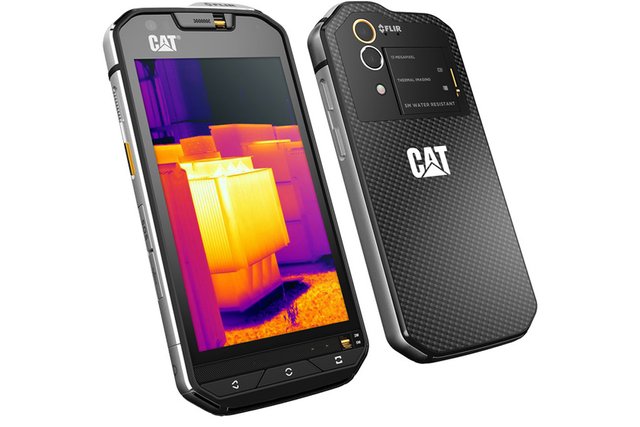
Other Affordable Thermal Imaging Cameras
There are of course some other affordable entry level products in the form of thermal cameras that you might be interested in such as the standalone FLIR TG165 Spot Thermal Camera that is also based on the FLIR Lepton sensor. There is also the standalone solution from Seek Thermal in the form of their Reveal, RevealXR and RevealPro product line. It is not only these two companies however, there are already some other quite interesting alternative products. For example there is the CAT S60 smartphone with an integrated thermal imaging camera (FLIR Lepton), so that you don't need to get a separate accessory for that functionality. There are also some other interesting projects for people into DIY such as the DIY-Thermocam project, so you might want to check that one out as well...
Some examples of Thermal Camera Usage in Music Videos
I wanted to make this kind of an introduction post about thermal cameras and I hope I did make it interesting, but since the topic actually needs more time and space I will continue with more details in an additional post. So without boring you with more information I will move to some videos that actually use thermal imaging cameras for some scenes or even for recording the whole thing to give you a better idea on what kind of images thermal cameras produce. Mind you these videos rely on much higher-end thermal cameras than the affordable consumer options I have covered above, so they are capable of recording high framerate videos with a significantly higher thermal resolution...
Emily Haines & The Soft Skeleton - Our Hell, a music video from 2007 apparently shot completely with a thermal imaging camera. The video uses a grayscale representation for the difference in temperatures with darker objects being colder and lighter ones being hotter.
Coldplay - Midnight, a more recent music video from Coldplay shot almost entirely with a thermal imaging camera, again using the grayscale type of representation of color temperature. They do mix some regular images as well in the video and the thermal range was probably not tweaked so well in order to try and more the colder background from the people that have higher body temperature (like in the first video), though that might be intentional as well.
Earl Sweatshirt - Grief, a music video from 2015 with a similar vision like the first video, shot entirely with a thermal imaging camera and again using the grayscale type of color representation of thermal data. The video does include some really nice and interesting scenes with water and fire.
Route 94 - My Love ft. Jess Glynne, a music video from 2014 that was shot almost entirely with a thermal imaging camera. Unlike all of the three above this one uses different color LUT for the representation of the thermal data, this style is one of the most common ones actually and it is called Iron. The colder objects are darker (black for the coldest), while the hotter ones are lighter (white), but the colors pass through blue, magenta, red, yellow in between the coldest and hottest parts.
Alan Walker - Sing Me To Sleep is a music video from this year and it features some shots made with a thermal imaging camera, though most of the video is shot with a regular camera and some special effects were used in it. Using only some frames and not recording and showing the whole thing in thermal imaging allows you to go for not so high-specs thermal camera. Here the Iron false color representation for the thermal data is used yet again like in the above video.
If you have a question or want to add something, then please leave a comment below.
Did you like what you have just read? Check my other posts on steemit @cryptos
If you like what I'm doing for Steem and on Steemit you can support me as a Witness
Next - Plasma mounted shoulder cannon.
Haha yeah I would like that!
Well, if things continue to go along the lines of the Predator movies... who knows :)
Awesome I was thinking the same thing, God I loved that movie!
We have a case of steempathy here :P I wanted to write an article on how thermal cameras on smartphones are going to be a privacy nightmare.
Hahaha, but based on my personal experience they are not really going to be a privacy nightmare at least based on what is currently being offered as afordable solutions... there are some stories that exaggerate the issue a bit, though they can still be misused just like many other technologies.
I already have seen cases where it can even be used for criminal purposes, like detecting presence and movement within a house, etc. And that's with the first iterations of the ultra-portable tech. I can only imagine what'll happen next.
As I said - every technology can be abused or misused in the wrong hands :)
has anyone thought of a way for this to be used practically with firearms? (for home defense purposes only of course)
There are different products in the form of scopes that also rely on thermal imagers, these are being offered to hunters...
mm..unfortunately i'm in california. but i PROBABLY (hopefully) wouldn't have to use a scope for HD. haha. plus the size of the screen of a smartphone would be useful.
Awesome! Been looking into thermal cameras--they're so incredible. Definitely want to consider purchasing something with thermal technology in the near future. Any other cameras you might recommend, such as these Allied Vision cameras, or maybe something with a Computar lens? Let me know, thanks! :)